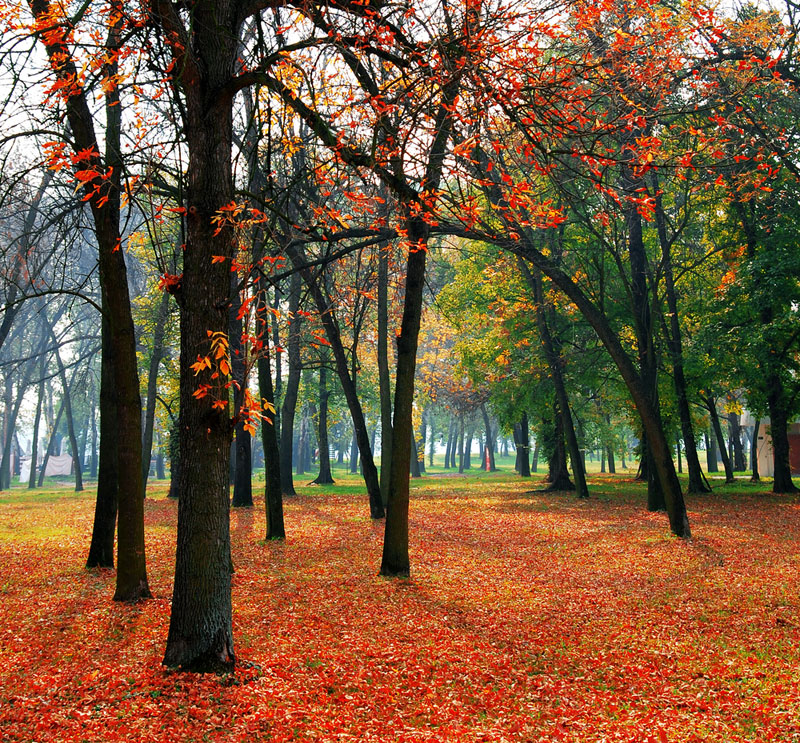Autumn Equinox: 5 Odd Facts About Fall

The pools have closed and crisp temperatures and crunchy leaves are on their way. Today (Sept. 22) marks the end of summer and the beginning of fall, also called the autumn equinox, in the Northern Hemisphere.
The autumn equinox occurs today at 4:44 p.m. EDT (20:44 UTC) when the sun is directly in line with Earth's celestial equator, or the equator projected onto the sky. Day and night last about equally long on Sunday, with about 12 hours of light and 12 hours of dark. This same phenomenon occurs on the spring equinox, which will next occur on March 20.
The date of the fall equinox (and its spring counterpart) varies slightly each year, sometimes falling on the 23rd or 24th depending on the quirks of the calendar, along with Earth's slightly irregular orbit. Here are five surprising facts about fall and the autumn equinox.
1. Amazing light shows
In addition to the brilliant colors of fall leaves, the autumn equinox signals another colorful spectacle — the aurora borealis, also called the Northern Lights. Besides the lengthening of nights and cool evening weather, which are great for stargazers, autumn truly is "aurora season," according to NASA. That's because geomagnetic storms are about twice as frequent as the annual average during the fall. [Aurora Photos: Northern Lights Dazzle in Night-Sky Images]
Particles that get discharged from the sun during such geomagnetic storms zip toward Earth at breakneck speed. As the particles slam into Earth's magnetic field, they bump into atoms and molecules of oxygen, nitrogen and other elements. The result? Dazzling light shows, with hues most commonly of pink, green, yellow, blue, violet and occasionally orange and white — depending on what elements the particles collide with.
2. Animals respond, testes swell
Get the world’s most fascinating discoveries delivered straight to your inbox.
Living things respond to the light changes that come with fall, with trees shedding their leaves and animals preparing for hibernation. Fall can bring an especially noticeable change to the high-attitude-living male Siberian hamster. That's because the rodent's testes swell up 17 times their size from short days to long; the swelling allows, in part, the animals to time reproduction properly.
Hamsters aren't the only creatures to herald in fall in strange ways. When autumn hits, the black-capped chickadee goes gangbusters collecting seeds and hiding them in hundreds of different spots in trees and on the ground. At the same time, the tiny bird's hippocampus balloons by 30 percent as new nerve cells pop up in this part of the brain, which is responsible for spatial organization and memory.
3. Full moon named for autumn
Autumn gets its own full moon, the Harvest Moon. From Wolf and Sturgeon to Hunter and Harvest, full moons are named for the month or season in which they rise. The Harvest Moon is the full moon closest to the autumn equinox, which occurred on the night of Sept. 18-19 this year.
Before artificial lighting, farmers took advantage of the full moon's light to harvest their crops. In late summer and early autumn, many crops ripen all at once, making lots of work for farmers who had to stay in the fields after sundown to harvest all the goods. Such moonlight became essential to their harvest, and the Harvest Moon emerged, according to NASA.
4. Why fall leaves may fade
Climate change may dull the picture most synonymous with autumn — fall leaves. Leaves change their wardrobes in response to chilly temperatures and less light (as days begin to shorten); they stop producing chlorophyll, the green pigment that helps leaves capture sunlight to power photosynthesis. As green fades, the leave's other pigments, such as the orange and yellow of carotenoids shine through. Vibrant red hues are the result of anthocyanins, pigments that are produced in the fall. [Photos of Turning Leaves: The Rich Colors of Fall Foliage]
These autumn colors could be some of the casualties of global warming, say scientists. Research has shown as the world warms, fall-colored leaves are delayed since their cues to change color come partly from cooling temperatures.
Fall's cool nights and sunny days also help to trigger trees like the sugar maple to store their anthocyanins temporarily in their leaves, giving leaf peepers a show of red. But if global warming leads to warmer nights, paired with autumn's shortening days, trees may not use their sugars to make red pigments, instead sending that fuel to twigs or burning it off, according to Howie Neufeld, a plant physiologist at Appalachian State University in North Carolina.
Climate change may also alter suitable habitats for trees like the sugar maple known to be big players in fall's vibrant colors.
5. When is the equinox?
The autumnal equinox falls on different dates each year, usually Sept. 22, like this year, or Sept. 23; but in 1931, the equinox happened on Sept. 24. The reason: The Gregorian calendar doesn't match up perfectly with the position of Earth in its orbit around the sun.
As Earth orbits the sun, it revolves around its axis at a 23.5-degree angle so that it is pointed directly toward the sun at the summer solstice, directly away from the sun during the winter solstice, and at a right angle with the sun on the equinoxes; that right angle means the sun shines about equal amounts of light across the Northern Hemisphere on the equinoxes. If this trek around the sun took exactly 365 days, Earth would be in its autumn equinox position on the same day each year. Since Earth takes 365.25 days to make a complete journey around the sun, the date is slightly different each year. The fall equinox won't happen again on Sept. 24 until 2303.
Follow Jeanna Bryner on Twitter and Google+. Follow us @livescience, Facebook & Google+. Original article on LiveScience.
Jeanna Bryner is managing editor of Scientific American. Previously she was editor in chief of Live Science and, prior to that, an editor at Scholastic's Science World magazine. Bryner has an English degree from Salisbury University, a master's degree in biogeochemistry and environmental sciences from the University of Maryland and a graduate science journalism degree from New York University. She has worked as a biologist in Florida, where she monitored wetlands and did field surveys for endangered species, including the gorgeous Florida Scrub Jay. She also received an ocean sciences journalism fellowship from the Woods Hole Oceanographic Institution. She is a firm believer that science is for everyone and that just about everything can be viewed through the lens of science.


